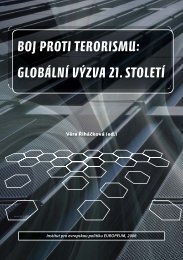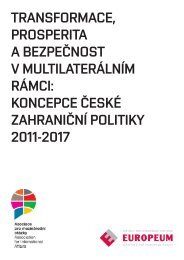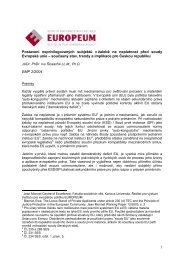eu constitutionalisation - EUROPEUM Institute for European Policy
eu constitutionalisation - EUROPEUM Institute for European Policy
eu constitutionalisation - EUROPEUM Institute for European Policy
Create successful ePaper yourself
Turn your PDF publications into a flip-book with our unique Google optimized e-Paper software.
Chapter 6: A ‘saut constitutionnel’ out of an intergovernmental trap?who, as Vice President of the Commission, is responsible <strong>for</strong> respective links.A potential pattern <strong>for</strong> a division of labour is indicated in the provisions dealingwith the general right of initiative <strong>for</strong> external actions: The document envisages“joint proposals” by the Foreign Minister and the Commission; the Minister“<strong>for</strong> the field of common <strong>for</strong>eign and security policy” and the Commission “<strong>for</strong>other fields of external action“ (Art. III-293 (2)). In assisting “the Council andthe Commission [to] ensure consistency” “between the different areas of itsexternal actions and between these and its other policies” (Art. 292 (3)) theUMFA might pursue a ‘catch-all’ strategy (see below); in such a constellationhe/she will rule deeply into major areas of the Commission’s external dossiers– including trade and development aid, but also in the external dimensionof internal issue – such as environmental affairs.Also in terms of administering the EU as global actor, the Commission willlose importance. The “<strong>European</strong> External Action Service”, which “shallcomprise officials from relevant departments of the General Secretariat ofthe Council of Ministers and of the Commission as well as staff secondedfrom national diplomatic services”, shall assist the UFMA (Art. III-296(3)). The autonomy of the Commission in handling its external relationswill be reduced considerably. For the Commission and its President the‘double-hat’ of the UMFA might imply serious organisational rivalry, whichhas already been documented by the behind-the-scene struggle over theone or two substitute(s) and potential replacements in case of the ForeignMinister’s absence³⁸.The <strong>European</strong> Parliament remains sidelined. The text has not increased theparticipatory powers of the EP in the field of CFSP. In replacing the rotatingPresidency and the Commission, the Foreign Minister will become thecontact person <strong>for</strong> the EP. Another dialogue partner will be the permanentchair of the <strong>European</strong> Council, who after each session will present a reportto the EP, which is most likely to include CFSP matters (Art. I-22 (2d)).Any powers to ratify international treaties have also been excluded: theEP is not even consulted be<strong>for</strong>e the adoption of international agreementswhich “relate exclusively to the common <strong>for</strong>eign and security policy” (Art.III-325 (6)), whereas those consultative powers have been extended to theEP on issues of Common Commercial <strong>Policy</strong> (Art. III-325 (6)).38) Ibid., p. 560.212Chapter 6: A ‘saut constitutionnel’ out of an intergovernmental trap?A further, if very limited, offer <strong>for</strong> some kind of dialogue is put down inthe “Protocol on the role of national parliaments in the <strong>European</strong> Union”,which envisages that “A conference of Parliamentary Committees <strong>for</strong>Union Affairs may … organise inter-parliamentary conferences on … mattersof common <strong>for</strong>eign and security policy, including common securityand defence policy.” (Title II, Art. 10 of the Protocol). Members of theEP participate in that body. So far COSAC has been a body of marginalimportance³⁹.The limits set <strong>for</strong> the EP as a public <strong>for</strong>um of secondary importance can beexplained by two lines of arguments. The marginal rights of the EP mightbe taken as an indicator <strong>for</strong> the singularity of this policy field, which usuallydemands fast, discrete and discretionary decision-making (the DDSSyndrome). Perhaps more important is a second reason: the constitutionaltreaty does not apparently view the EP as legitimating factor <strong>for</strong> this centralarea of the Union. National governments and diplomats are perceived tobe the only legitimated actors, as they derive their general mandate fromdomestic sources.As previously, CFSP matters are excluded from the jurisdiction of theCourt of Justice (Art. III-376); again the Convention and the IGC remainedin the intergovernmental mood of the previous IGCs. The text mighthave extended the jurisdiction of the Court to procedural issues – not atleast to protect smaller member states from attempts of the ‘big three’ toestablish some kind of directoire⁴⁰.4.1.2.2. The Union minister of <strong>for</strong>eign affairs: high on expectations – low on powerThe creation of a ‘Union Minister <strong>for</strong> Foreign Affairs’ (UMFA) (Art. I-28)stands out as the most central innovation of the proposed institutionalarchitecture. Generally, this ‘double--hatted’ figure is assessed as a “majorachievement”⁴¹.After establishing a small secretariat in the middle of the 1980s and creatingthe function of a “High representative” in the Amsterdam Treaty, the mastersof the constitutional treaty have taken a further step towards founding39) See MAURER and WESSELS (2001)40) THYM (2004), p. 16.41) <strong>European</strong> Commission (2003) 548 final, p. 11.213








